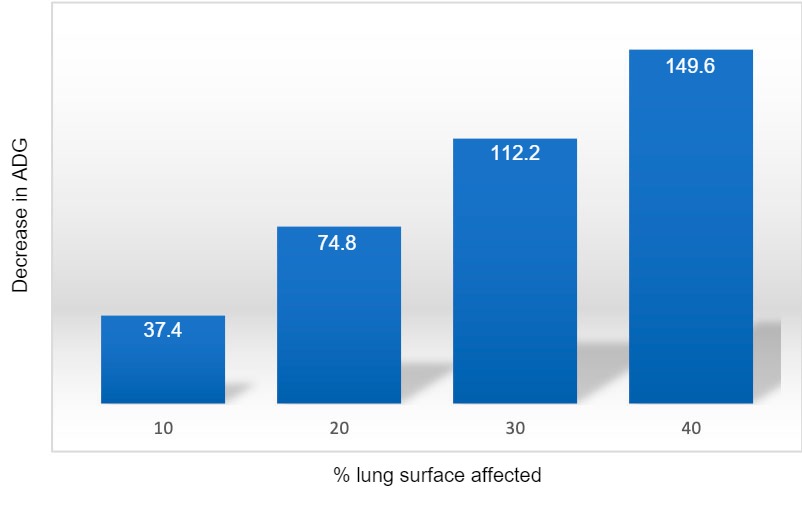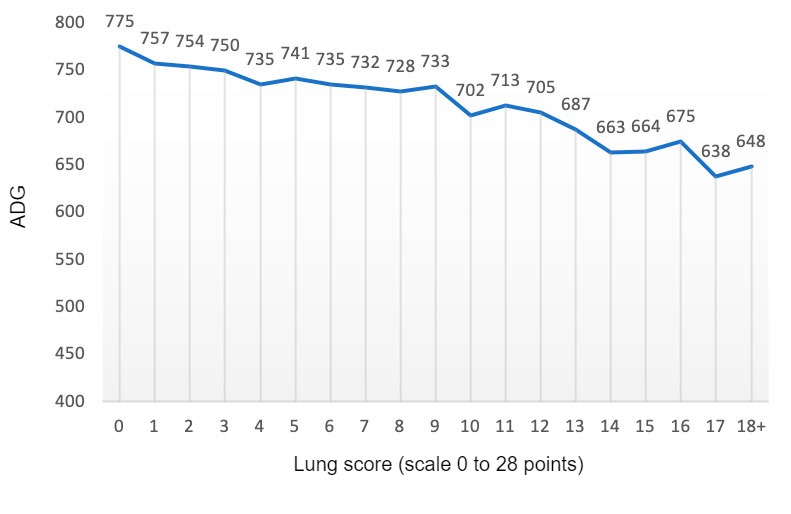As we already know, the main function of the respiratory system is to capture oxygen from the air and eliminate the CO2 created by tissue catabolism. However, in the pig it is also responsible for carrying out the thermoregulation process, since the pig does not have developed sweat glands. Therefore, the animal must eliminate excess heat through an evaporation system called thermal polypnea. Excess heat is known to cause reduced growth, as we can see on our farms when the summer heat arrives. Therefore, if the respiratory function of the pig is compromised due to a pneumonic process, its thermoregulatory capacity will also be altered, resulting in a decrease in feed intake, which leads to a delay in growth and, therefore, a lower economic performance of the farm.
One of the first studies in which this relationship was investigated was by Straw et al. (1989), where by comparing the percentage of damaged lung area with the growth of the animals, they were able to show that there was a decrease in the average daily gain (ADG) of 37.4 grams for every 10% of lung area affected by pneumonia (Figure 1).


Figure 1: Decrease in ADG (grams) in relation to the percentage of the lung surface affected by pneumonia. Adapted from Straw et al. (1989).
In another study by Pagot et al. (2007), about 7,000 pigs from 14 farms in France were individually weighed and their lungs examined at the slaughterhouse. It was found that there was a negative correlation between the prevalence of lung lesions and growth. A reduction of about 0.7% in the ADG for each point of increase in lung lesions was quantified (Figure 2). Average growth was about 3% less in pigs that had lung lesions at slaughter than those without.

Figure 2: ADG value (grams) in relation to the lung score (scale of 0 to 28 points). Adapted by Pagot et al. (2007).
In this study, the lung lesion scoring system proposed by Madec and Kobisch (1982) was used, in which the lung score totals between 0 and 28 points, with each of the seven lung lobes being scored between 0-4 points, where 0 corresponds to no lesions, 1 if the lesion area is less than 5 cm2, 2 for a larger lesion area but making up less than half the pulmonary lobe surface, 3 when the lesion area is larger but there is still healthy tissue, and 4 if the lobe is totally affected. The presence of pleuritis was also assessed in this study, with a mean prevalence of 10%. In animals that simultaneously presented pneumonia (score of 4 or higher) and pleuritis, growth was 15% less than in those that did not have pleuritis.
The economic impact of the presence of chronic pleurisy in slaughterhouses was also studied by Sorensen et al. (2014), who estimated that a 16% increase in the frequency of appearance of this lesion has a cost of 0.1 € per pig.
One of the diseases that has been studied the most in terms of the relationship between the presence of lung lesions in the slaughterhouse and the reduction in animal growth (and therefore the economic cost) is enzootic pneumonia (EP), which is a disease caused by Mycoplasma hyopneumoniae, and is one of the processes that causes the most losses in the pig industry. Vaccines against this pathogen have been shown to decrease the incidence of lung lesions at slaughter and increase the growth of the animals, which translates into a clear economic benefit. In relation to this process, Bringas et al. (2014) conducted a study in which they evaluated the incidence of lung lesions consistent with EP at the slaughterhouse and the production data of just over 48,000 animals.To do this, they compared production data in pig batches with different ranges of lung lesions, grouping the batches into four groups: incidence of lesions <55%, incidence between 56-76%, incidence between 77-88% and incidence >88%. In this study, they found that when moving from the group with the lowest incidence of lung lesions (<55%) to the highest (>88%) there was a decrease of 42 grams in the ADG, an increase of 50 grams in the feed conversion ratio (FCR), an increase of 0.9% in mortality and an increase of 0.84 € in costs. Thus, depending on conditions, the disease could increase the production cost by about 2.7 € per pig.
Table 1: Values for the main production parameters in different batches of animals according to incidence of lung lesions. Adapted from Bringas et al. (2014).
| Lesion incidence | ADG | FCR | % mortality | Cost of medication, € |
|---|---|---|---|---|
| <55% | 687 | 2.51 | 2.41 | 1.93 |
| 56-76% | 671 | 2.54 | 2.76 | 1.98 |
| 77-88% | 662 | 2.52 | 3.01 | 2.43 |
| >88% | 645 | 2.56 | 3.31 | 2.77 |
Lung lesions have a marked effect on the pig's main production parameters, so controlling respiratory pathogens is essential to minimize losses and improve the profitability of our farms.



